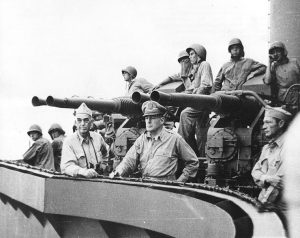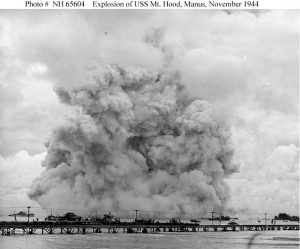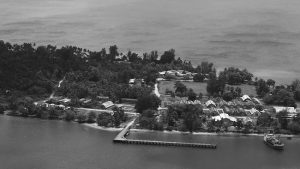- Author
- A.N. Other
- Subjects
- History - WW2
- Tags
-
- RAN Ships
- HMAS Tarangau
- Publication
- June 2013 edition of the Naval Historical Review (all rights reserved)
Previous editions of this magazine have focused on the histories of Cocos, Christmas and Nauru Islands as they formed part of the Government’s Pacific Solution for asylum seekers. This article mainly referring to Manus Island completes this series.
Early History
The islands have been inhabited for many thousands of years forming part of the migration route from southeast Asia towards Australia. They were first known to early Spanish and Dutch navigators but the name Admiralty Islands was conferred by Captain Philip Carteret, RN during his world circumnavigation in HM Sloop Swallow between 1766 and 1769. The islands remained largely undisturbed until claimed as a German colony in 1884. During the short-lived 30 year period of German colonisation impressive development took place in parts of the Bismarck Archipelago. In the Admiralty Islands this was mainly confined to establishing extensive coconut plantations around the eastern end of Seeadler Harbour, mostly on Los Negros. Following the outbreak of WWI the islands were occupied by troops of the Australian Naval and Military Expeditionary Force and later formed part of the Territory of Papua and New Guinea governed by the Commonwealth. When Papua New Guinea’s independence was declared in 1975, sovereignty of the entire former territory, including, the Admiralty Islands, was vested in the new Independent State of Papua New Guinea.
Strategic Importance
The Admiralty Islands are a group of islands in the Bismarck Archipelago about 320 km north of New Guinea. Only two degrees south of the equator they are hot and humid with a high average rainfall especially during the monsoon seasons. Manus is the largest island about 100 km long and 30 km miles wide with rugged jungle covered terrain rising to over 700 meters. The total land area of these islands is 2,100 km supporting a current population of 43,000. The main town of Lorengau is situated on Manus and is connected by a road bridge to an airport on Los Negros Island. Seeadler Harbour, one of the largest and best in the southwest Pacific lies within an ellipse formed by Manus Island and the curving shore of the adjacent Los Negros Island and other reef bound smaller islands to the north. Its protected waters some 24 km long and 6 km wide are capable accommodating a large fleet.
War comes to the islands
In November 1941 a small observation post manned by a Section from the 1st Independent Company of the AIF was established on Manus. Led by Lieutenant Palmer this 25 man Section’s objective was to report enemy movement and then resist the enemy long enough so that airfields, fuel supplies etc. could be damaged and destroyed. The war came to them on 25 January 1942 when eight Japanese float planes first bombed the islands intent on destroying the radio masts. Two aircraft were shot down. Further air raids occurred in February and in March enemy aircraft conducted an intense aerial search trying to locate Australian forces. On 8 April Japanese forces of the 8th Special Base Force landed and began construction of airstrips at Lorengau on Manus Island and at Momote on nearby Los Negros Island. A defensive garrison of about 4,500 men was established to deny this strategically important area to the Allies. Ironically the early 19th century clearance of jungle covered land by German pioneers greatly assisted the establishment of defence facilities during WWII, initially by the Japanese and later by Allied forces. The small Australian force despite encounters with Japanese patrols and suffering from sickness mostly managed to escape. Remarkably they stole a small ketch and schooner from under Japanese guard and then sailed over 200 miles through enemy controlled waters to eventually reach the safety of the New Guinea mainland.
Commencing on 29 February 1944 overwhelming American forces attacked the islands and after a relatively short but bitter engagement quickly gained a beachhead and captured the Momote airstrip. Fierce counter attacks were made but the Japanese suffered heavy losses and without hope of re-supply resistance gradually faded other than for small isolated pockets of resistance which continued for some time. Allied casualties amounted to 294 killed and 977 wounded but Japanese losses were considerably greater with no prisoners recorded other than 68 Sikhs of the Indian Army, captured at Singapore and impressed as labour.

The importance of the operation can be gauged by the fact that after Momote was captured both General McArthur and Vice Admiral Kinkaid came ashore to inspect the potential of the airstrip. Action then began working around the clock in undertaking one of the most amazing feats of military engineering of WWII. In less than one year, using a labour force of over 20,000 men led by Seabees, they transformed this remote and undeveloped area into a modern naval air centre and fleet support facility. This included constructing airfields (the Mokerang airstrip was over two miles long), power plants, water reticulation, fuel and ammunition storage depots, communications centre, maintenance and repair facilities, training and recreation facilities, accommodation and a 1,000 bed hospital. This was augmented by port facilities and two floating docks capable of accommodating the largest naval ships. The Advance Base Section Docks (ABSD) were capable of lifting 90,000 tons each and readily accepted the 45,000 ton battleship USS Iowa when she conducted an emergency docking here in December 1944. Incredibly by the end of the year the new naval base was beginning to rival Pearl Harbor. Perhaps honouring these achievements in June 1944 the USN commissioned a new escort carrier USS Admiralty Islands, she unfortunately had a very short career being decommissioned in April 1946.
Buildings were largely on the “Quonset” (named after Quonset Point the US Naval Construction base at Rhode Island) type; these were lightweight prefabricated corrugated steel with a semicircular cross-section and could be assembled quickly.
A tragedy occurred on 10 November 1944 when the 14,000 ton supply ship USS Mount Hood carrying about 4,000 tons of munitions exploded when at anchor in the harbour. Nothing remained of the ship and her crew and those in lighters and small boats near her. The result of the explosion also caused extensive damage to the repair ship USS Mindanao. The tragedy resulted in the deaths of 430 men with many others being injured. The cause of the explosion remains unresolved.

USAAF
The vast British Pacific Fleet (BPF) which had assembled in Sydney used Manus as a forward base in their provision of Allied support for the final push against the Japanese. The fleet under Vice Admiral Rawlings flying his flag in the battleship HMS King George V arrived at Manus on 7 March 1945. Following replenishment and continuation of work-up, especially of anti-aircraft defences, which was mainly provided by American resources the fleet was able to sail on 19 March. The BPF was quickly into action which added to Allied superiority resulting to the earlier than expected conclusion of hostilities. The Admiralty Island base can therefore be credited in significantly helping in the early and successful conclusion of the war against Japan. The US Navy air base on Ponam Island was loaned the BPF where the Fleet Air Arm established a Mobile Naval Air Base (MONAB IV) which on 2 April 1945 was commissioned as HMS Nabaron. Nabaron was later extended to include another USN air base on the remote Pityilu Island. These were somewhat unkindly described by an RN source as ‘Scapa Flow with bloody palm trees’. With the Japanese surrender in September 1945 these forward bases were no longer required and after an operational life of only 7 months HMS Nabaron decommissioned on 10 November 1945 and the bases returned to USN control.
One last parting shot by the enemy occurred in April 1945 when the islands were overflown at high level by a Japanese recognisance plane which sighted the two floating docks and possibly confused these with aircraft carriers. A few days later these were attacked by a single aircraft releasing an aerial torpedo bomb which struck and damaged one of the docks.
Post War Developments
Late in 1945 the United States entered into discussion with the Commonwealth seeking continued long-term rights, without sovereignty, over its facilities in the Admiralty Islands. The Melbourne Argus of 06 June 1947 carried a front page story “Manus planned as great empire naval base”. This implied that by extending existing facilities a major base would be established at Manus instead of Singapore and Hong Kong. This proposal had the support of both the Australian and British Governments. After prolonged negotiations with no agreement evident the United States decided to withdraw and move its most important assets to Guam and others were simply dumped at sea. The remainder were mostly sold to the Chinese Nationalist Government who employed a labour force of 300 Chinese on the islands in 1947/48 to strip and ship assets to Shanghai. Australian authorities were left with what remained but most significantly a valuable oil fuel installation. This became important to refuelling ships later bound for the Korean conflict and during Confrontation, thereby avoiding passing through the Indonesian Archipelago, and again during the Vietnam War. The Australian Government paid the United States Government $US 1.25m for these assets which included about 1,500 serviceable Quonset huts, some of which made their way back to Australia to be used as migrant hostels.
Prisoner of War Camp
A darker side of the islands history occurred in the early 1950s when over two hundred Japanese being held in prison camps in Japan and suspected of war crimes against Australians were sent to Los Negros for trial. The trails began in June 1950 and 91 were brought to trial with over one third acquitted of all charges. The highest ranking officer to be tried was General Hitoshi Imamura who had commanded the Japanese 8th Army based at Rabaul, where he surrendered with his forces on cessation of hostilities. General Hitoshi was sentenced to ten years imprisonment. Others received sentences ranging from two years imprisonment to the death sentence. Twelve men all convicted in the participation of murder of Australian and Allied prisoners of war were sentenced to death, however seven of these had their sentences later commuted to life improsment. The five executed included Lieutenant-General Takuma Nishimura, three junior officers and one warrant officer. They were executed ashore and their bodies taken out to sea and committed to the deep. In 1953 all remaining prisoners were repatriated to Japan to serve the outstanding periods of their sentences.
HMAS Tarangau
An RAN shore establishment named HMAS Tarangau was first established at Dreger Harbour near Finschhafen in 1946. A few years later in 1949 the base was closed and its personnel, stores and equipment transferred to a redevelopment of ex US facilities established at Lombrum Point on Los Negros which had previously been the site of a Burns Philp plantation. Immediately post war some of these facilities were also used to house Japanese prisoners of war convicted of war crimes. By 1949 most of the neglected ex US facilities were in poor repair and much had reverted to the jungle. However the new base was commissioned as HMAS Seeadler (German for sea eagle) on 1 January 1950; the name was changed back to HMAS Tarangau (a native word with the same meaning) on 1 April of the same year. Training of local naval recruits began in September 1951 and gradually expanded to the development of a PNG Division and in January 1968 the first of five patrol boats built for service in PNG waters, HMAS Aitape, arrived at Tarangau. In January 1973 in preparation for PNG’s independence the naval component was redesignated as the Maritime Element of the PNG Defence Force. On 14 November 1974 an end of an era was reached when HMAS Tarangau and her attendant patrol boats HMA Ships Aitape, Ladava, Samarai, Lae and Madang and two LCHs HMA Ships Buna and Salamaua were decommissioned and recommissioned as PNGDF Patrol Boat Base Lombrum with the ships becoming part of the PNGDF.

The Present Day
Since independence and with continued Australian support the PNGDF has faced a number of difficulties. Its forces have been reduced and suffer from inadequate maintenance and shortage of equipment. There are now about 200 personnel in the Maritime Element with small bases at Port Moresby, Manus and Milne Bay supporting the two aged landing craft and four later generation Pacific class patrol boats, one of which is rather surprisingly named Seeadler.
The Pacific Solution and Offshore Processing Centres
In 2001 the Australian Government was struggling to find a solution to the increasing number of asylum seekers arriving by boat. Previously the highest number to arrive in a single year had been 953 persons who came in 1994. Suddenly in 1999 this increased to 3,721 arrivals and in 2001 to 5,516 arrivals.
An agreement was signed on 10 September 2001 between the Australian Government and the Government of Nauru to accommodate asylum seekers during the processing of their applications. In return Australian agreed to an increased aid package to support the ailing Nauruan economy. Initially 664 asylum seekers were transported to Nauru in HMAS Manoora and shortly after another group were taken in HMAS Tobruk bringing the centre to near full capacity.
On 8 October 2001 a team of Australian officials flew to PNG to seek an agreement to house asylum seekers using spare capacity at the Lombrum Naval Base on Los Negros. A MOU was signed on 11 October 2001 and a trust fund established to cover any extra expenses incurred by PNG. The first refugees to land at the new facility were flown from Christmas Island on 22 October 2001. These were 209 men, women and children from a small vessel which had been intercepted by HMAS Adelaide.
In February 2002 the total offshore numbers of refugees peaked at 1,515 with Nauru housing 1,159 mainly from Afghanistan and Iraq and PNG housing 356 mostly from Iraq. With relatively rapid progress in processing visa applications by the end of November 2002 these numbers had dropped with 719 persons held at Nauru and 91 at PNG. Numbers continued to decline and by February 2003 only 16 were in PNG and the last guests departed from Lombrum in early 2004. However the facility was not officially closed until 31 March 2008 when the site and its assets were returned to the PNG Government.
Since opening in 2001 to closure in 2008 a total of 1,637 persons had been detained at Nauru and PNG. After 2001 there was a marked decline in boat arrivals with refugees into Australian waters. It could therefore be argued that the Pacific Solution was an effective deterrent. While the 2001 scheme had bipartisan approval within the Australian government the new Labour Government elected in 2007 decided to close offshore processing centres as of 31 March 2008. Whether this decision may have influenced migration events is arguable but the outcome was a record increase in the numbers of asylum seekers arriving in Australian waters. Last year (2012) there were a record number of 278 boats arriving with a total of 17,202 persons potentially claiming refugee status. While seeking more humane alternatives the Government was forced into re-opening the Nauru and Manus centres.
The first group of 19 Sri Lankan and Iranian asylum seekers were flown to Manus on 21 November 2012. They are currently being housed in “G Camp” within temporary facilities at the Lombrum naval base. The site can house up to 600 asylum seekers but as of April 2013 the centre housed about half this number (270) which included men, women and children.
Looking for Answers
The past three editions of this magazine have examined the histories of Cocos and Christmas Islands in the Indian Ocean and the Admiralty and Nauru Islands in the Pacific. These remote and geographically dispersed communities have little in common excepting a thread of German and Australian interest brought about by the events of WWI and again by competing Japanese and Australian interests during WWII. The islands were then largely undisturbed until a temporary solution was sought to stem the growing flow of boats carrying asylum seekers into Australian waters.
Human migration is a centuries old phenomenon and behaviour unlikely to be halted by the action of a single government. However nations have the right to place certain controls over the sovereignty of their borders. Whether this should include off-shore processing centres over which there may be no jurisdiction is debateable. Society generally has to improve control mechanisms concerning asylum seekers, whether political refugees or would-be economic immigrants. Australia and its neighbours must work together finding better solutions to the asylum seeker problems; otherwise an inordinate amount of resources will be expended on piecemeal controls with little likelihood of success. The RAN has a difficult role to play in these matters within the context of the Australian Government’s Border Protection Command.




